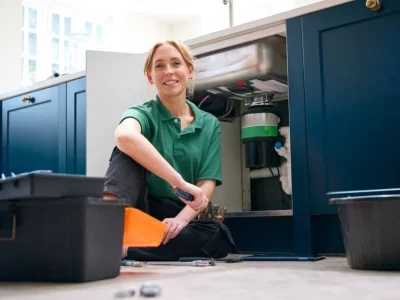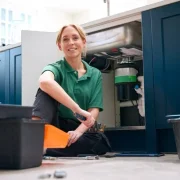With the warm seasons upon us, you are probably wondering how to get rid of wasps or bees.
There’s no denying that these insects serve a vital role in our ecosystem, particularly in pollination. However, when they make our home their home, it’s a different matter. Their stings can be painful and dangerous, especially for those of us with allergies.
There are natural and safe methods for wasp and bee pest control. This guide by pest control experts will detail how to handle these uninvited guests, recognise the difference between a bee and a wasp, and recognise when it’s time to call pest exterminators.
Use essential oils
Essential oils, nature’s very own aromatic extracts, provide an effective and natural method for bee and wasp pest control. Certain oils such as peppermint, citronella, and eucalyptus or a mix of clove-geranium-lemongrass oils are particularly potent to these insects, thanks to their strong fragrances.
Creating a homemade deterrent is as simple as blending a few droplets of these oils with water in a spray bottle. If you are planning to spray it on surfaces, you can add dish soap so it sticks better. Once prepared, spritz this mixture around specific areas that have attracted bees or wasps, such as entrances, patios, or even identified nests. Inside the house, you can also use an aroma diffuser to keep the insects at bay.
But remember, despite their natural origins, these oils are intensely concentrated. It’s crucial to use them in moderation, as an excess might cause undesirable effects, like skin irritation or an overpowering smell. So, use sparingly and observe your surroundings – you’ll not only witness a reduction in these unwelcome visitors but also enjoy a wonderfully fragrant home environment. Essential oils serve as a safe, pleasant, and effective step in your comprehensive pest control strategy.
Set up wasp traps
While bees are typically less aggressive than wasps, the latter can become a real nuisance. Setting up wasp traps is an effective wasp pest control measure which can reduce their numbers. When you hire pest control services, you will be offered commercially available traps. However, if you’re tight for money, you can make some yourself.
A simple DIY trap can be created using a plastic bottle, water, and some sugar. Wasps enter these traps and are unable to leave, eventually drowning. Remember to check and empty these traps regularly. The only downside to this trap is that it can inadvertently ensnare bees as well, but that’s a chance you have to take.
Make a soap and water solution
Here’s another simple yet surprisingly effective wasp pest control method: a basic solution of dish soap mixed with water is a formidable adversary for wasps. Why so? The soapy mixture forms a filmy layer over the wasps’ breathing pores, literally taking their breath away. What’s more, this approach lets you maintain a safe distance from the wasps and their nests.
Simply fill a spray bottle with the solution, aim, and spray. Remember, though, safety comes first. Always make sure to spray from a distance and protect yourself adequately. Soon enough, you’ll see a noticeable decline in the number of unwelcome visitors.
Plant insect-repellent plants
Certain plants have a reputation for repelling bees and wasps. The more prominent ones include wormwood, eucalyptus, thyme, peppermint and citronella. Planting any of these in your garden can help establish a natural barrier against these insects. Additionally, they enhance the aesthetics of your outdoor spaces, making it a win-win situation. It’s quite ironic that you should use plants for bee pest control purposes, but what can you do?
Make necessary repairs
Bees, and particularly wasps, have a knack for turning the nooks and crannies of our homes into their own personal homes. By maintaining a vigilant eye and ensuring your home is in tip-top condition, you can deter these industrious insects from setting up shop.
Be particularly mindful of areas like the undersides of roof eaves, the corners of window frames, and any visible cracks in walls. A timely repair here and there goes a long way in keeping these buzzing houseguests at bay. How to get rid of bees or wasps? Well, by not allowing them to enter in the first place is the best way.
Dispose of garbage properly
Disposing of garbage properly is another essential step in your wasp and bee control strategy. Both bees and wasps have a bit of a sweet tooth, they’re drawn to food waste, particularly anything sugary. Wasps take it a notch further with a craving for meat.
To keep these buzzing troublemakers at bay, it’s important to keep your bins tightly sealed and to empty them on a regular basis. As an extra layer of defence, why not give those bins a regular spritz with the essential oil solution we talked about earlier? This combo of cleanliness and deterrent can drastically cut down on unwanted bee and wasp visits around your bins.
How to tell the difference between a bee and а wasp?
Eny pest exterminator will tell you that distinguishing between a bee and a wasp isn’t merely an exercise in entomology – it’s crucial due to their differing behaviours and the varying consequences of their stings.
At first glance, bees exhibit a fuller, robust body, which upon closer inspection, reveals a furry texture. This is a consequence of tiny hairs used in their vital role as pollinators. They also have flat, broad legs suited for carrying pollen. Conversely, wasps feature a slender, streamlined body with a conspicuous narrow waist and shiny, hairless surface. They also have cylindrical legs, unlike the flat ones seen in bees.
Behaviourally, bees are typically less aggressive, stinging primarily in self-defence. This is due to their barbed stinger which, once used, results in their death. Wasps, however, are known for their hostility, capable of stinging multiple times without succumbing, thanks to their smooth, retractable stinger. Understanding these nuances can inform your responses to these insects, and remember, both play essential roles in our ecosystem.
When to call pest control services for help
If you encounter a nest within your home or an infestation that feels beyond your capabilities, then it might be time to consider calling in pest control experts. These specialists are equipped to handle such circumstances, utilising their vast experience and specialised equipment to safely and effectively deal with wasps and relocate bees from your premises.
Their proficiency ensures the task is carried out with minimal risk to you, your property value, or the ecosystem. So, if a severe pest problem arises, don’t hesitate to reach out to the professionals. Their intervention can make the difference between a persistent issue and a swift resolution.
Conclusion
Dealing with bees and wasps is no small feat, but armed with knowledge and a few simple strategies, you can keep these buzzing intruders at bay. And remember, while it’s important to protect our homes, it’s equally crucial to remember the ecological importance of these flying creatures.
So before reaching for harsh chemicals or the phone to call in the exterminators, give these natural, DIY methods a try. However, if an infestation gets out of hand, don’t hesitate to contact professional pest control services. Safety, after all, should always be your top priority.












Comments